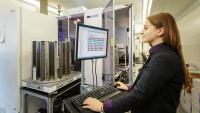Research
Research at the Center for Radiological Research

The Center for Radiological Research (CRR) is a worldwide leader in unraveling the biological and molecular mechanisms underlying radiation effects in cells, tissues, organ systems, and living organisms. A basic understanding of the process(es) whereby ionizing radiation results in cellular damage and the mechanism(s) whereby cells respond to and repair injury is fundamental to evaluating the human health risks of exposure as well as for optimizing the responsible use of ionizing radiation to diagnose and treat human disease, including cancer.
In addition to basic research, the CRR is part of the Department of Radiation Oncology at Columbia University Irving Medical Center assiting in translational research to furthering theraputic outcomes using radiation. We are also in collaboration with other clinical departments at the Medical Center and at other institutions, helping to bring research findings from the lab bench to the bedside.
NIH, NASA, DOE, and other federally funded CRR research addresses a broad range of questions including molecular details of radiation-induced DNA damage and the and repair, activation and regulation of specific genes following ionizing radiation exposure, the role of microRNA’s (miRNA) in regulating the damage/repair response, and the chemistry and pathological role of reactive oxygen intermediates and free radicals following radiation exposures.
The Far-UVC projects also look at the uses of non-ionizing radiation as a techology to help in the prevention of disease transmission through aersol means in both hospital and general population setting. Far-UVC has the ability to kill airborne viruses and bacteria while not being harmful to the skin and eyes of the people.
A large program project grant addresses multiple cellular signaling questions surrounding the Radiation Bystander Response; how cells not directly damaged by ionizing radiation exposure nevertheless are affected by irradiation of nearby cells. Future translation of these findings into clinical practice has direct implications regarding the potential effects of cancer radiotherapy on neighboring healthy tissue.